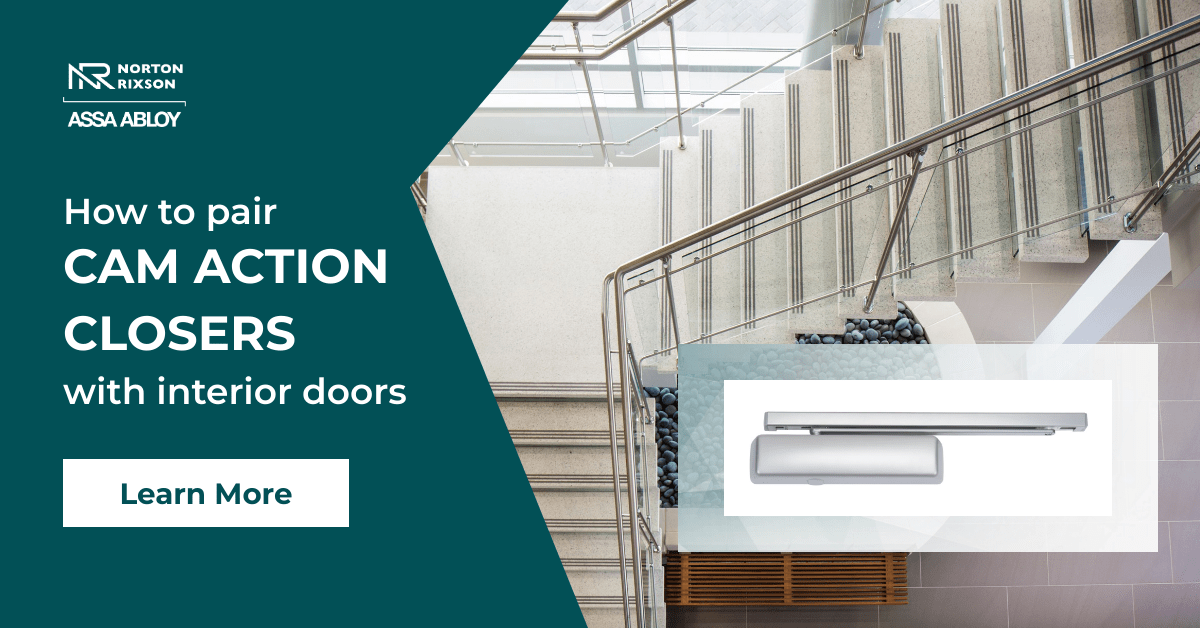How to Pair Cam Action Closers with Interior Doors
Cam action closers are a smart choice when doors need to reliably close while maintaining a low opening force for accessibility.

Cam action closers are a smart choice when doors need to reliably close while maintaining a low opening force for accessibility.
Proper door closure is a major concern in commercial buildings. But solving this issue turns into a paradox – increasing the door’s closing force increases opening force, undermining accessibility requirements. The best solution is a cam action closer, a mechanical device that balances closing and opening force.
Door closers are essential on exterior doors to overcome environmental conditions as well as preserve security. But there are several interior applications as well, especially where life safety and ADA compliance are concerns.
Two interior use cases for cam action closers are 1) stairwells and 2) high-traffic doors.
1) Stairwell Towers
Stairwell doors often have difficulty closing due to the force of pressurization and the stack effect. Both conditions can prevent a door from latching properly. This compromises security and life safety, leaving the stairwell vulnerable to smoke infiltration in the event of a fire.
Stairwell doors may also have trouble closing when they have heavy gasketing. Even if the door isn’t rated for smoke protection, gaskets are a best practice because they help seal against smoke as well as air movement. However, gaskets can create drag as the door closes, slowing it to a halt before it can shut fully.
The typical response to either scenario is to adjust spring tension to increase the door’s closing force. But that has the drawback of making the door harder to open, which represents an unacceptable liability in the event of an emergency. How to solve this dilemma?
A cam action closer will do what a rack and pinion closer can’t – overcome stack or drag during closing while maintaining a low force when opening. It achieves this by delivering a higher closing force at the critical junction of 10-15 degrees from the close position.
Cam action closers are fundamentally different than rack and pinion closers. A rack and pinion closer overcomes spring compression with a gear that moves along a grooved track. A cam action evenly distributes the spring compression through roller bearings, a vertical follower, and the cam itself. This equalization results in smoother operation. Learn more in our post How Cam Action Closers Overcome Latching Issues.
2) High-Traffic Doors
Public restrooms are a fantastic opportunity to add a cam action closer. Front-of-house bathrooms are heavily frequented by users across all mobility levels. The smooth operation of a cam action closer improves the guest experience while ensuring the door closes for privacy.
Another interesting use case for a cam action closer is an interior door that opens in front of another door, such as a closet or utility area The usual solution is to add a floor- or wall-mounted stop. But these may not be suitable for security or aesthetic considerations. The Norton Rixson 2800ST Series Cam Action Closer comes with an adjustable track stop, allowing architects and designers to modify the open path to prevent the door from swinging into nearby objects. It also eliminates the need for stop hardware .
Retrofits and Cam Action Closers
Renovation projects are an ideal time to upgrade to cam action closers. Any facility undergoing modernization should evaluate door performance.
Good candidates for upgrading to a cam action closer are doors that are tough to open, don’t close or latch consistently, or are showing their age. Doors being updated for accessibility, such as switching knobs to levers, can also be retrofitted with a closer at the same time.
Interested in learning more about our cam action? Fill our the form below to get in touch with our team of experts.